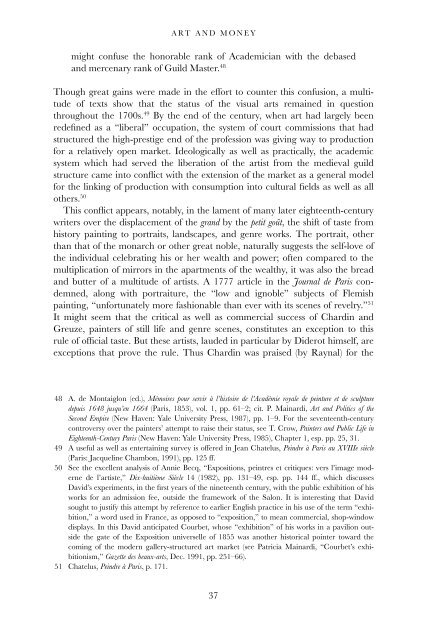Art in its Time: Theories and Practices of Modern Aesthetics
Art in its Time: Theories and Practices of Modern Aesthetics
Art in its Time: Theories and Practices of Modern Aesthetics
You also want an ePaper? Increase the reach of your titles
YUMPU automatically turns print PDFs into web optimized ePapers that Google loves.
ART AND MONEY<br />
might confuse the honorable rank <strong>of</strong> Academician with the debased<br />
<strong>and</strong> mercenary rank <strong>of</strong> Guild Master. 48<br />
Though great ga<strong>in</strong>s were made <strong>in</strong> the effort to counter this confusion, a multitude<br />
<strong>of</strong> texts show that the status <strong>of</strong> the visual arts rema<strong>in</strong>ed <strong>in</strong> question<br />
throughout the 1700s. 49 By the end <strong>of</strong> the century, when art had largely been<br />
redef<strong>in</strong>ed as a “liberal” occupation, the system <strong>of</strong> court commissions that had<br />
structured the high-prestige end <strong>of</strong> the pr<strong>of</strong>ession was giv<strong>in</strong>g way to production<br />
for a relatively open market. Ideologically as well as practically, the academic<br />
system which had served the liberation <strong>of</strong> the artist from the medieval guild<br />
structure came <strong>in</strong>to conflict with the extension <strong>of</strong> the market as a general model<br />
for the l<strong>in</strong>k<strong>in</strong>g <strong>of</strong> production with consumption <strong>in</strong>to cultural fields as well as all<br />
others. 50<br />
This conflict appears, notably, <strong>in</strong> the lament <strong>of</strong> many later eighteenth-century<br />
writers over the displacement <strong>of</strong> the gr<strong>and</strong> by the petit goût, the shift <strong>of</strong> taste from<br />
history pa<strong>in</strong>t<strong>in</strong>g to portra<strong>its</strong>, l<strong>and</strong>scapes, <strong>and</strong> genre works. The portrait, other<br />
than that <strong>of</strong> the monarch or other great noble, naturally suggests the self-love <strong>of</strong><br />
the <strong>in</strong>dividual celebrat<strong>in</strong>g his or her wealth <strong>and</strong> power; <strong>of</strong>ten compared to the<br />
multiplication <strong>of</strong> mirrors <strong>in</strong> the apartments <strong>of</strong> the wealthy, it was also the bread<br />
<strong>and</strong> butter <strong>of</strong> a multitude <strong>of</strong> artists. A 1777 article <strong>in</strong> the Journal de Paris condemned,<br />
along with portraiture, the “low <strong>and</strong> ignoble” subjects <strong>of</strong> Flemish<br />
pa<strong>in</strong>t<strong>in</strong>g, “unfortunately more fashionable than ever with <strong>its</strong> scenes <strong>of</strong> revelry.” 51<br />
It might seem that the critical as well as commercial success <strong>of</strong> Chard<strong>in</strong> <strong>and</strong><br />
Greuze, pa<strong>in</strong>ters <strong>of</strong> still life <strong>and</strong> genre scenes, constitutes an exception to this<br />
rule <strong>of</strong> <strong>of</strong>ficial taste. But these artists, lauded <strong>in</strong> particular by Diderot himself, are<br />
exceptions that prove the rule. Thus Chard<strong>in</strong> was praised (by Raynal) for the<br />
48 A. de Montaiglon (ed.), Mémoires pour servir à l’histoire de l’Académie royale de pe<strong>in</strong>ture et de sculpture<br />
depuis 1648 jusqu’en 1664 (Paris, 1853), vol. 1, pp. 61–2; cit. P. Ma<strong>in</strong>ardi, <strong>Art</strong> <strong>and</strong> Politics <strong>of</strong> the<br />
Second Empire (New Haven: Yale University Press, 1987), pp. 1–9. For the seventeenth-century<br />
controversy over the pa<strong>in</strong>ters’ attempt to raise their status, see T. Crow, Pa<strong>in</strong>ters <strong>and</strong> Public Life <strong>in</strong><br />
Eighteenth-Century Paris (New Haven: Yale University Press, 1985), Chapter 1, esp. pp. 25, 31.<br />
49 A useful as well as enterta<strong>in</strong><strong>in</strong>g survey is <strong>of</strong>fered <strong>in</strong> Jean Chatelus, Pe<strong>in</strong>dre à Paris au XVIIIe siècle<br />
(Paris: Jacquel<strong>in</strong>e Chambon, 1991), pp. 125 ff.<br />
50 See the excellent analysis <strong>of</strong> Annie Becq, “Expositions, pe<strong>in</strong>tres et critiques: vers l’image moderne<br />
de l’artiste,” Dix-huitième Siècle 14 (1982), pp. 131–49, esp. pp. 144 ff., which discusses<br />
David’s experiments, <strong>in</strong> the first years <strong>of</strong> the n<strong>in</strong>eteenth century, with the public exhibition <strong>of</strong> his<br />
works for an admission fee, outside the framework <strong>of</strong> the Salon. It is <strong>in</strong>terest<strong>in</strong>g that David<br />
sought to justify this attempt by reference to earlier English practice <strong>in</strong> his use <strong>of</strong> the term “exhibition,”<br />
a word used <strong>in</strong> France, as opposed to “exposition,” to mean commercial, shop-w<strong>in</strong>dow<br />
displays. In this David anticipated Courbet, whose “exhibition” <strong>of</strong> his works <strong>in</strong> a pavilion outside<br />
the gate <strong>of</strong> the Exposition universelle <strong>of</strong> 1855 was another historical po<strong>in</strong>ter toward the<br />
com<strong>in</strong>g <strong>of</strong> the modern gallery-structured art market (see Patricia Ma<strong>in</strong>ardi, “Courbet’s exhibitionism,”<br />
Gazette des beaux-arts, Dec. 1991, pp. 251–66).<br />
51 Chatelus, Pe<strong>in</strong>dre à Paris, p. 171.<br />
37
















